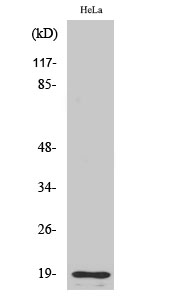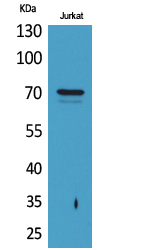Cleaved-Thrombin APII (R327) Cell-Based Colorimetric ELISA Kit
- Catalog No.:KA3977C
- Applications:ELISA
- Reactivity:Human
- Gene Name:
- F2
- Human Gene Id:
- 2147
- Human Swiss Prot No:
- P00734
- Mouse Swiss Prot No:
- P19221
- Storage Stability:
- 2-8°C/6 months
- Other Name:
- Prothrombin (EC 3.4.21.5) (Coagulation factor II) [Cleaved into: Activation peptide fragment 1;Activation peptide fragment 2;Thrombin light chain;Thrombin heavy chain]
- Detection Method:
- Colorimetric
- Background:
- catalytic activity:Selective cleavage of Arg-|-Gly bonds in fibrinogen to form fibrin and release fibrinopeptides A and B.,disease:Defects in F2 are the cause of various forms of dysprothrombinemia [MIM:176930].,disease:Genetic variations in F2 may be a cause of susceptibility to ischemic stroke [MIM:601367]; also known as cerebrovascular accident or cerebral infarction. A stroke is an acute neurologic event leading to death of neural tissue of the brain and resulting in loss of motor, sensory and/or cognitive function. Ischemic strokes, resulting from vascular occlusion, is considered to be a highly complex disease consisting of a group of heterogeneous disorders with multiple genetic and environmental risk factors.,function:Thrombin, which cleaves bonds after Arg and Lys, converts fibrinogen to fibrin and activates factors V, VII, VIII, XIII, and, in complex with thrombomodulin, protein C. Functions in blood homeostasis, inflammation and wound healing.,miscellaneous:It is not known whether 1 or 2 smaller activation peptides, with additional cleavage after Arg-314, are released in natural blood clotting.,miscellaneous:Prothrombin is activated on the surface of a phospholipid membrane that binds the amino end of prothrombin and factors Va and Xa in Ca-dependent interactions; factor Xa removes the activation peptide and cleaves the remaining part into light and heavy chains. The activation process starts slowly because factor V itself has to be activated by the initial, small amounts of thrombin.,miscellaneous:The cleavage after Arg-198, observed in vitro, does not occur in plasma.,miscellaneous:Thrombin can itself cleave the N-terminal fragment (fragment 1) of the prothrombin, prior to its activation by factor Xa.,online information:Thrombin entry,pharmaceutical:The peptide TP508 also known as Chrysalin (Orthologic) could be used to accelerate repair of both soft and hard tissues.,PTM:The gamma-carboxyglutamyl residues, which bind calcium ions, result from the carboxylation of glutamyl residues by a microsomal enzyme, the vitamin K-dependent carboxylase. The modified residues are necessary for the calcium-dependent interaction with a negatively charged phospholipid surface, which is essential for the conversion of prothrombin to thrombin.,similarity:Belongs to the peptidase S1 family.,similarity:Contains 1 Gla (gamma-carboxy-glutamate) domain.,similarity:Contains 1 peptidase S1 domain.,similarity:Contains 2 kringle domains.,tissue specificity:Expressed by the liver and secreted in plasma.,
- Function:
- protein import into nucleus, translocation, cell activation, regulation of protein amino acid phosphorylation, positive regulation of protein amino acid phosphorylation, acute inflammatory response, protein amino acid phosphorylation,proteolysis, protein targeting, protein import into nucleus, phosphorus metabolic process, phosphate metabolic process, ion transport, cation transport, calcium ion transport, cellular ion homeostasis, cellular calcium ion homeostasis, cellular metal ion homeostasis, intracellular protein transport, nucleocytoplasmic transport, apoptosis,activation of caspase activity, defense response, acute-phase response, inflammatory response, cell surface receptor linked signal transduction, elevation of cytosolic calcium ion concentration, intracellular signaling cascade, protein kinase cascade, JAK-STAT cascade, tyrosine phosphorylation of STAT protein, STAT protein n
- Subcellular Location:
- Secreted, extracellular space.
- Expression:
- Expressed by the liver and secreted in plasma.
- June 19-2018
- WESTERN IMMUNOBLOTTING PROTOCOL
- June 19-2018
- IMMUNOHISTOCHEMISTRY-PARAFFIN PROTOCOL
- June 19-2018
- IMMUNOFLUORESCENCE PROTOCOL
- September 08-2020
- FLOW-CYTOMEYRT-PROTOCOL
- May 20-2022
- Cell-Based ELISA│解您多样本WB检测之困扰
- July 13-2018
- CELL-BASED-ELISA-PROTOCOL-FOR-ACETYL-PROTEIN
- July 13-2018
- CELL-BASED-ELISA-PROTOCOL-FOR-PHOSPHO-PROTEIN
- July 13-2018
- Antibody-FAQs


